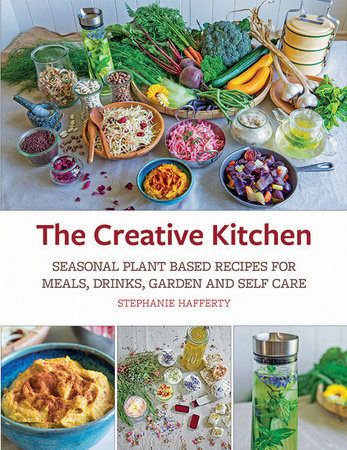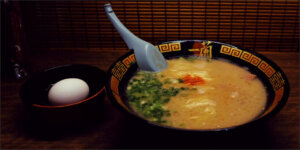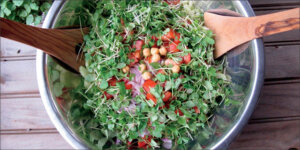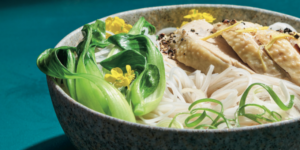Kick Your Kimchi Up a Notch!
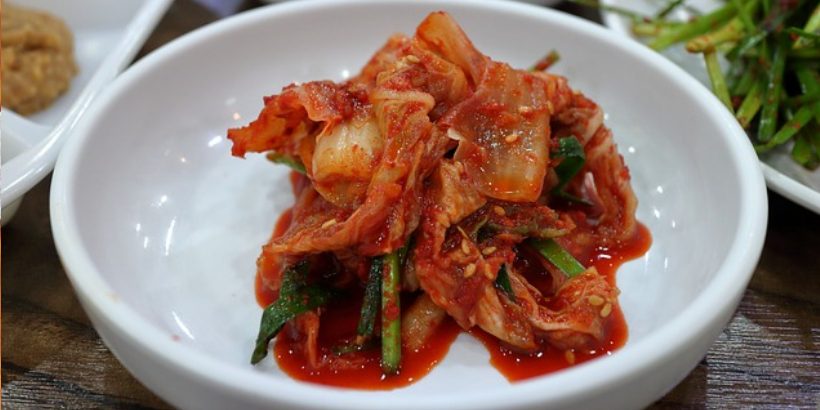
If you’ve been looking to spice up your kimchi game, this is it. Sandor Ellix Katz, author of Sandor Katz’s Fermentation Journeys and award-winning book The Art of Fermentation, is here with a new spin of the classic kimchi recipe.
The following is an excerpt from Sandor Katz’s Fermentation Journeys by Sandor Ellix Katz. It has been adapted for the web.
For the 2019 Ferment Oaxaca event, my presentation was “Cross-Cultural Fermentation: Kimchi, Dosas, Koji, and More Using Corn and Other Local Ingredients.” In preparation, I experimented at home using corn in all of these ferments and more, with great success. One of the best was tempeh made with corn, pinto beans, and quinoa, as pictured here.
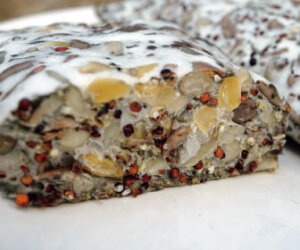
Corn, pinto bean, and quinoa tempeh.
I arrived in Oaxaca a few days before the summit. I had always heard intriguing things about Oaxaca, and I was excited to finally see and experience it. The morning after I arrived, I went to Mercado Benito Juárez, a vast indoor food market. The market is a maze in the center of the city, filled with hundreds of small vendors. My mission was to assemble ingredients for a Mexican-style kimchi. The major concept I had premeditated was to use fresh masa dough (ground nixtamalized corn) as the basis for a spice paste. It was easy to find that in the market; it was also easy to find the spices we wanted, and the veggies. Chapulines—crunchy, spiced grasshoppers that are widely eaten in some parts of Mexico—and pineapple were both abundant at the market, and they more or less suggested themselves. We bought some of each, the chapulines being almost exactly analogous to using tiny dried shrimp in some Korean kimchi.
I offer this not so much as a recipe to be followed but rather as an example of how to substitute what is available and abundant for ingredients that are more typically used. After I made the chapulín kimchi, I visited my friends Daniel and Paulina at their business, Suculenta, and they gave me a taste of their delicious kimchi made with chicatana ants.
Mexican-Inspired Kimchi
Timeframe
A few days to 1 week
Vessel
Crock, wide-mouth jar, or another vessel with a capacity of at least 2 quarts/2 liters
Ingredients
for 2 quarts/2 liters
- 3 pounds/1.5 kilograms cabbage and/or radishes and/or other vegetables
- 6 tablespoons salt
- A few chilies, any type, fresh or dried, for moderate spice; more for spicier
- About 4 tablespoons/
- 70 grams masa
- 1 garlic head (to taste)
- 4 tablespoons grated fresh ginger (to taste)
- 1 pineapple
- 1 large or 2 small onions and/or bunches of scallions, coarsely chopped
- 4 tablespoons/20 grams chapulines (to taste, optional)
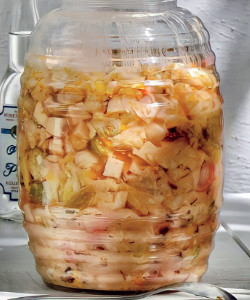
My Oaxacan kimchi with chapulines and pineapple.
Process
Coarsely chop the vegetables and place in a bowl or pot. Salt the vegetables generously as you shred them.
Add just enough water to cover the vegetables, then set a plate on top of them to keep them submerged. Leave the vegetables submerged in brine on the kitchen counter for about 24 hours.
If you are using dried chilies, rinse them and cover them with a little water to allow them to hydrate for at least a few hours (or up to 24 hours). When you are ready to make the spice paste, remove the chilies from the soaking water, and use the soaking water as some of the water for the next step. If you are using fresh chilies, skip this step.
Make the paste. In a small saucepan, mix the masa with about 1 cup/250 milliliters of cold water (including any chili-soaking water). Stir well to break up the masa in the water, then gently heat at a moderate temperature, stirring constantly to prevent burning. Cook for a few minutes as the mixture thickens into a starchy, gooey paste. It should be thick, but still runny. If it seems too thick, add a little more water and stir well. Remove the masa paste from the heat and leave it to cool.
Mince the chilies with their seeds. Peel and coarsely chop the garlic.
Mix the chilies, garlic, and ginger into the masa paste and stir until well combined.
Drain the brine off the vegetables. Really let it drain, and even press lightly to force water out. Taste the vegetables for saltiness. That initial salting mostly pulls water out of the vegetables, but not much of it absorbs into them. If you cannot taste salt, add 1 to 2 teaspoons salt to the spice paste. In the unlikely event that the vegetables are too salty, rinse them.
Prepare the pineapple. Remove the peel and core, reserving them for tepache (Tepache, page 18). Cut the sweet, tender flesh into small pieces.
Combine everything together. Place the drained vegetables in a large mixing bowl. Add the spice paste and mix to distribute it. Add the onions, pineapple, and chapulines, if you are using them. Mix everything together well.
Pack the kimchi into the vessel. Pack it tightly, pressing down until the paste or liquid rises to cover the vegetables. Weigh down the vegetables to keep them submerged. If you’re using a jar, leave a little space for expansion.
Ferment in a visible spot in the kitchen. If you are using a sealed jar, be sure to loosen the top to relieve pressure each day for the first few days. While you are there, use your (clean!) fingers to push the vegetables back under the brine, and after a few days taste the kimchi. As the days pass it will be less sweet and more sour. When making a kimchi with fruit, I like to eat it while the fruit still has some sweetness, so I can enjoy all the contrasting flavors. In this case, I would ferment it no longer than a week—probably less.
Once it tastes ripe to you, move it to the refrigerator.
Recommended Reads
Recent Articles
Miso soup is the perfect, soul-healing meal. Not only does this soup taste great, it also has amazing health benefits!
Read MoreDoes the cold weather have you dreaming about fresh greens and colorful salad? Grow and harvest sprouts indoors to make those dreams a reality!
Read MoreWinter just got cozier! Our simple & nourishing soup is just what you need to cozy up on chilly days or nights! Delicious and nutritious, this soup is perfect for the whole family.
Read MoreIndulge in the sweet aroma of these pastry-wrapped pears! Easy to make and stunning to serve, these pastry-wrapped pears are a game-changer.
Read MoreDitch boring snacks and upgrade to adorable fruit & veggie treats you’ll love! Brighten up snack time this winter using fruits and veggies we all know and love. Can you resist taking a bite of these cuties?
Read More



